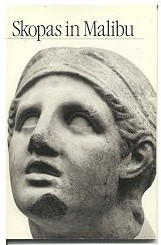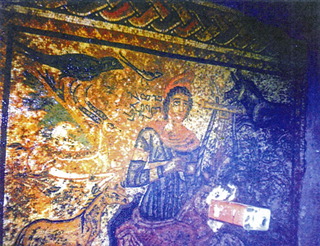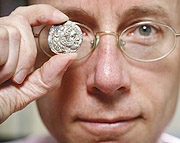 UPDATE 7/5/16: After years of stonewalling, the Ny Carlsburg Glyptotek has agreed to return hundreds of looted antiquities to Italy. In a joint announcement released July 5, 2016, Italy and the Danish museum said they had reached an agreement for the return that included loans and broad cooperation on cultural matters. “Investigations have shown that the objects had been unearthed in illegal excavations in Italy and exported without licence, which is why from a point of reason and common sense there is a consensus that these particular objects should return to Italy,” the release said.
UPDATE 7/5/16: After years of stonewalling, the Ny Carlsburg Glyptotek has agreed to return hundreds of looted antiquities to Italy. In a joint announcement released July 5, 2016, Italy and the Danish museum said they had reached an agreement for the return that included loans and broad cooperation on cultural matters. “Investigations have shown that the objects had been unearthed in illegal excavations in Italy and exported without licence, which is why from a point of reason and common sense there is a consensus that these particular objects should return to Italy,” the release said.
Update 7/7/16: My friends at POLITIKEN, the Danish newspaper, have provided a list of the 501 objects and fragments the Glyptotek has agreed to return to Italy, with inventory numbers from the museum:
· 110 etruskiske arkitektoniske fragmenter fra Cerveteri og Veii, inv.
nr. HIN 696-800 og HIN 802-806
· 150 genstande fra grav XI (Colle del Forno nekropolis i Sabina) med
en etruskisk vogn, inv. nr. HIN 527-550, HIN 552-668, HIN 670-
672 og HIN 675
· 17 arkitektoniske fragmenter, inv. nr. IN 3426-3442
· 19 etruskiske genstande fra Vulci og Cerveteri, inv. nr. HIN 676-
693 og HIN 695
· 59 individuelle antikke genstande, inv. nr. IN 3500 og IN 3502-
3559
· 14 etruskiske genstande fra Vulci og Cerveteri, inv. nr. HIN 807-
820
· 98 arkitektoniske fragmenter og antefixer fra Veii, inv. nr. HIN 822-
919
· 34 individuelle antikke genstande, inv.nr. IN 3415, IN 3417-3419,
IN 3423-3424, IN 3444-3445, IN 3447, 3498-3499, IN 3570-3576,
IN 3606-3607, IN 3622-3623, IN 3625, HIN 522-526, HIN 669, HIN
673-674, HIN 821 og HIN 920-921
It is easy to forget that American museums were not the only ones caught in Italy’s investigation of the illicit antiquities trade.
The Getty, the Met, the Boston MFA, the Cleveland Museum and Princeton received most of the attention for being linked to the network supplied by antiquities trafficker Giacamo Medici. But Medici objects were also traced to museums and collectors in Germany, Denmark, France, Switzerland, Australia, Japan.
Today, eighteen years since the raid on Medici’s warehouse, at least one European museum is still refusing to return clearly looted material: the Ny Carlsburg Glyptotek in Copenhagen.
Camilla Stockmann, an arts journalist at the Danish daily Politiken, has followed the story since 2006 and recently wrote me with an update: despite years of negotiations, the Copenhagen museum and Italy have still not reached an agreement.
What makes the Glyptotek’s foot-dragging particularly striking is the quality of evidence supporting Italy’s claims. Medici’s criminal sentence identified several objects in the museum that are shown in Polaroids seized in Medici’s warehouse: a terracotta relief depicting a chariot race; an acroterion (roof ornament) depicting a winged sphinx; and terracotta reliefs that comprise a pair of mounted warriors.

Then there is the tomb of an Etruscan prince from the Sabine Hills outside Rome, show above. It includes the Prince’s shield, weapons, banqueting equipment and bronze incense burners. Most striking are the remains of a horse-drawn carriage. “From Etruria and Latium, which stretched south west of the River Tiber, only a limited number of similar tombs are known,” the museum boasts in its display text.
The tomb in question, archaeologists have concluded, is in the Colle del Forno necropolis. It was looted shortly before being discovered by Italian archaeologists in 1970. “Fortunately the tomb raiders didn’t do a thorough job,” Italian archaeologist Daniela Rizzo testified in Medici’s trial. Additional material from the tomb was recovered and is now on display in the archaeological museum of Fara in Sabine, waiting to be reunited with the objects in Copenhagen.
Hecht’s memoir recounts purchasing the entire set from Medici for $67,000 and selling it to the Copenhagen museum for $1.2 million Swiss francs, or about $240,000.
Finally, there are the Glyptotek’s Etruscan antefixes depicting Maenad and Silenus. They bear an uncanny resemblance to the one the Getty Museum acquired in 1996 and put on the cover of the its antiquities catalog before returning it to Italy. The Getty acquired its antefix from the Fleischmans, who purchased it from the Hunt Collection, which was largely composed of material from Medici.
Are the antefixes related? Pictures tell the story: on the left if the Getty’s, returned to Italy in 2007. On the right is one of the Copenhagen antefix, which remain at the Glyptotek.
And here are the Polaroids seized from Medici’s warehouse showing the antefixes soon after emerging from the ground:


Further evidence about the Glyptotek’s role in the illicit trade comes from Medici’s principal connection to the art market, American antiquities dealer Robert Hecht.
Mogens Gjødesen, the museum’s director from 1970 to 1978, was tight with Hecht, a frequent visitor to the museum. In in his handwritten memoir, Hecht describes sharing pickled herring and drinking akvavit with Gjødesen and his wife on several occasions. “A former curator told me that he (Hecht) was called the ironmonger amongst the employees since he always showed up with a plastic bag with artefacts that he wanted to sell,” says Stockmann.
Indeed, Hecht’s handwritten memoir reveals that when he first obtained the famous Euphronios krater from Medici, he offered it first to Gjødesen, who unsuccessfully “tried to get a Danish shipman to buy it for the Glypt.”
The journal also reveals that Hecht appears to have sold the Glyptotek illicitly exported silver figures from Greece: “After my wife’s departure I went to Greece and was shown a magnificent group of geometric AE figurina* (now in coppenhagen). (*Helmeted nude rider, 2.) This group was appreciated by the Carlsberg Foundation & was acquired by the Glypotech within a few months. This group has both an artistic + a cultural interest. A helmeted mounted horseman, 2 horses back to back, the upper half of a youth, a potter at work, a miniature helmet, et. Al. The patina is smooth, pea green.”
The Danish Stonewall
When confronted with this evidence, the Glyptotek initially denied any acquisitions from Medici or his associates after 1970. As evidence emerged that contradicted that, their position shifted. Stockmann says:
“Until 2007 The Ny Carlsberg Glyptotek denied any wrongdoing but after substantial politic pressure the museum sent documents about the items bought from Medici and Hecht during the 1970s to Italy. In 2007 Italy asked for a great number of items returned. Since 2008, the Ny Carlsberg Glyptotek and the Italian Ministry of Culture have tried to reach an agreement.”
In 2009, the New York Times reported that those negotiations had bogged down. While most American museums had managed to reach agreements with Italy on contested material, Italy’s top negotiator said the Glyptotek “had taken a very different attitude.”
Recently talks have restarted, Stockmann told me. Both sides agree that all items related to the tomb of the Etruscan Prince should be returned to Italy in exchange for comparable loans. But the terracotta antefixes have “been the subject of a conflict.” In particular, Italy objects to language in a draft agreement on cultural cooperation that would prevent it from bringing further claims in the future.
Usually, stonewalling is a good sign that problems go far deeper. So I’ve looked into our archives to see what else I could find.
Gjødesen and the Getty Forgeries
As it happens, Gjødesen was a visiting scholar at the Getty Museum in 1978 and 1978, just as his directorship at the Glyptotek was coming to an end. While at the Getty, he had the opportunity to weigh in on two important acquisitions being considered by the museum.
The first was an archaic relief showing a Greek soldier binding the head of a fellow warrior. The Getty’s crooked antiquities curator Jiri Frel dubbed it The Death of a Hero. Several experts were dubious about the authenticity of the relief, noting the execution of details like the closed eye seemed off for the Archaic period. At $2.3 million dollars, it was not a decision to be made lightly.
Gjødesen’s opinion helped sway the board, Getty records show. In a letter to Frel dated December 14, 1978, he wrote:
From time to time it happens that a discovery is made which elaborates, extends or totally changes our conception of Greek art. This has happened once again. I am, of course, referring to the archaic Attic relief, dating from about 525 B.C. which you have determinedly tracked down during the past years and are now in a position to submit to the Board of Trustees of the J. Paul Getty Museum with a view to its acquisition.
You have asked my opinion. To put it bluntly, the relief is a sublime masterpiece of incredible subtlety, sentiment and expressiveness, a work of grace, intimacy and poetry, with a surprising touch of realism. It needs no letter of recommendation.
He added a key detail to clinch the objects’ authenticity:
So far the master remains anonymous, though not unknown to us, for in 1958 a relief, obviously by the same hand although of a different but for the time equally unexpected theme, was unearthed at Anavysos in Attica and brought to the Athens National Museum.
He concluded:
It is a miracle that this piece of sculpture was produced and is preserved. It is an even greater miracle that it is available. The opportunity should not be missed; it is unlikely to return. I cross my fingers for you and for the museum.
The Getty acquired the piece for $2.3 million in 1979. There are indications that Frel received a substantial kickback in the deal. Soon after, experts from around the world condemned the relief as a crude fake. The carving was incorrect, particularly the heads and hands, noted Brunhilde Ridgeway. The fragmentary image was impossible to reconstruct in a credible way, and no funerary relief of the Archaic period was known to have the same proportions.
In the 1980s, the Getty declared it a fake and returned it to the dealer.
 It was not the only fake whose praises Gjødesen sang while at the Getty. Soon after the archaic relief was acquired, a head attributed to the legendary master Skopas was offered to the Getty. It had been “in a private French collection since the 1830s” and considered “one of the most important pieces of ancient art in the United States,” Frel claimed.
It was not the only fake whose praises Gjødesen sang while at the Getty. Soon after the archaic relief was acquired, a head attributed to the legendary master Skopas was offered to the Getty. It had been “in a private French collection since the 1830s” and considered “one of the most important pieces of ancient art in the United States,” Frel claimed.
Gjødesen was among the scholars who lent support to Frel’s claims. The Skopas head was later established to be a modern forgery.
Was Gjødesen fooled? Or was he, like Frel, part of a scheme whose depths we have not fully plumbed? And when will the Copenhagen museum come clean?































